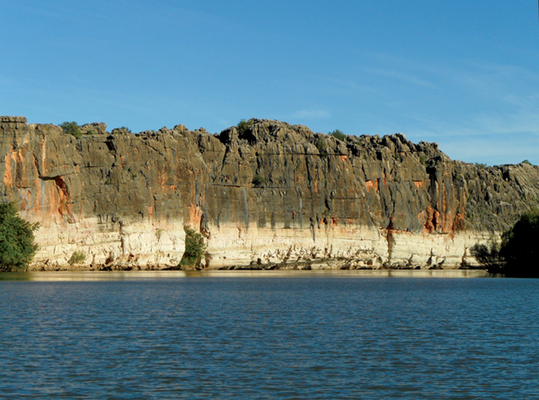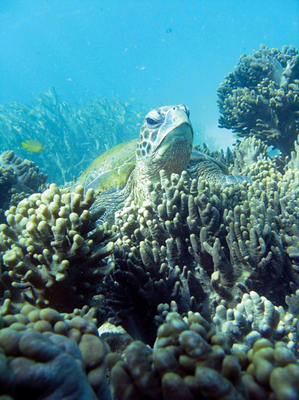
by Terri Cook and Lon Abbott Thursday, January 5, 2012

Geikie Gorge is one of the three national parks where visitors can see the Devonian Great Barrier Reef. Terri Cook and Lon Abbott

Turtle at Ningaloo Reef, one of the world's longest fringing reefs. s-ron mckellar, Creative Commons Attribution-NoDerivs 2.0 Generic
In Western Australia, you can visit two unusually accessible coral reefs. Although they look similar enough to be fraternal twins, these reefs were born nearly 400 million years apart. Ningaloo is a modern coral reef where you can snorkel amid spectacular reefbuilding organisms by wading just a few meters from the sandy, white shore. One of the longest fringing reefs on the planet, Ningaloo also boasts one of the planet’s healthiest reef environments, where 500 species of fish, 600 species of shellfish and more than 250 species of coral thrive.
Ningaloo’s older twin lies about 400 kilometers inland. The now-dry Devonian-aged “Great Barrier Reef” is so well-preserved it is as if the water drained away only yesterday. Spread across three national parks, it is widely recognized as the world’s best example of an ancient barrier reef. Its creamy limestone layers provide an unparalleled window into the past, allowing scientists and visitors alike to see which species constructed the reef and how they did so. By exploring Western Australia’s modern and extinct reefs, you can trace what has changed, and what has remained the same, over this long interval of reef construction.
At 260 kilometers in length, Ningaloo is the world’s only large reef located so close to a continent. With its crest lying just 100 meters to a few kilometers offshore, you can see waves breaking along it from the beach. Because the reef is located in a transition zone between tropical and temperate waters, Ningaloo Marine Park supports an unusual diversity of plants and animals. Even beginner snorkelers can enjoy the amazing variety of marine life, from butterfly fish and clownfish to Spangled Emperors and eels, living in and around colorful coral gardens.
Ningaloo is internationally renowned as one of the few places where whale sharks, Earth’s largest fish, regularly congregate in near-shore waters. They arrive in the austral autumn following a boost in local productivity associated with the mass spawning of coral. Ningaloo Marine Park is also home to other species of sharks, as well as green, loggerhead and hawksbill turtles; giant manta rays; dugongs; dolphins; and humpback and other whales.
Whether you don flippers or board a small boat to explore Ningaloo, you will first cross a flat area known as the back reef or lagoon, where horizontal layers of limey sediment accumulate in a quietwater area. Farther from shore, the reef crest, the highest part of the complex, separates the lagoon from the fore reef, where layers of debris that slope steeply seaward accumulate.
Back on land, you can see these same three depositional environments in the Devonian reef, despite the fact that the water drained away by 360 million years ago after an abrupt drop in sea level. Geologists identify each of these facies by the depositional dip of the limestone’s bedding and by the fossil species, because different organisms lived on each part of the reef. The easiest place to experience the ancient reef is at Geikie Gorge, the most accessible of the three national parks. Here the Fitzroy River has carved a picturesque canyon that slices through the reef. A ride up the river on a park-operated boat will transport you back to the Australia of 375 million years ago, where you can journey from the Devonian open ocean to an ancient lagoon.
Where the boat departs, the limestone layers forming the gorge’s fluted walls tilt steeply toward you. This is the fore reef facies, the reef’s steep seaward side. Like at Ningaloo, this is the site of greatest reef growth, but it is also a place of reef destruction. Storm waves from the open ocean battered the reef, tearing off fragments that slid into the deep water in front of the reef. This process created the layer of coarse, poorly sorted limestone debris (called breccia) visible at the top of the cliff. As you listen to the ranger’s commentary and scan the water for freshwater crocodiles, keep an eye out for the transition to massive (unlayered) limestone of the reef core. This is difficult to spot, as it is only found in a few locations in the gorge.
Like Ningaloo, the Devonian reef core protected a shallow lagoon from the waves that battered the fore reef. The first horizontal layers you see — part of the Pillara Limestone Formation — mark your passage into the shallow, quiet waters of the lagoon. A host of calcite-secreting organisms thrived here, and through the years their shells accumulated to form flat-lying limestone layers. The identities of the reef-building organisms were different from reefbuilders today. Whereas Ningaloo is built by scleractinian corals and calcareous algae, Devonian reefs were constructed by stromatoporoids (a now-extinct type of sponge), tabulate and rugose corals (also now extinct) and cyanobacteria.
After you travel through what used to be a lagoon, near the point where the boat turns around, you enter a modern valley formed in less resistant layers deposited in an inter-reef basin, which in the Devonian was almost completely encircled by reef platforms. Upstream you get another good look at the steeply dipping layers of the fore reef facies, part of the Napier Formation. At this point you have crossed through the entire ancient reef, from the open ocean to the inter-reef basin.
During the Devonian, reefs reached their greatest extent in Earth’s history, covering nearly 10 times the area of modern reefs. Western Australia’s reefs were among the most extensive of all, stretching a thousand kilometers along the ancient continent’s mountainous shore, flanking a rift that formed at that time just south of modern Australia’s Kimberley region. As the ocean floor sagged during Middle to Late Devonian rifting, the reef-building organisms kept pace, building upward and outward until sections of the reef measured more than 2 kilometers thick. But then, 374 million years ago, the reefs were devastated by the first in a series of major extinction events that occurred in quick succession. Together, these rapidfire events comprise the Late Devonian mass extinction, one of the five largest in history. Afterward, reef areas shrank dramatically because many major reefbuilding organisms, including tabulate corals and stromatoporoids, never recovered their diversity. Reef ecosystems as a whole did not recover for the remainder of the Paleozoic.
Following the extinction, the glass sponge Hydnoceras temporarily filled the ecological niche vacated by the extinct reef-builders. This switch is one of many clues suggesting that the Late Devonian mass extinction was triggered by global climatic cooling, as modern glass sponges live in cool waters. This cooling may have been triggered by the rise of terrestrial plants. By the Middle Devonian, the world’s first forests were growing on land. Their broad root systems caused Geikie Gorge is one of the three national parks where you can see the Devonian Great Barrier Reef. Western Australia is home to both living and fossil reefs. extensive chemical weathering of rockforming minerals, which consumed atmospheric carbon dioxide, contributing to the cooling. The Devonian mass extinction, which was especially cruel to warmth-loving marine organisms, was also marked by widespread anoxia (severe oxygen depletion) in the oceans. Such anoxia, which likely contributed significantly to the severity of the extinction, may have been caused by a massive overturn of ocean waters caused by the global cooling.
After being dealt the initial blow 374 million years ago, the Devonian reef staggered on for another 14 million years until the last of the Devonian extinction events and a fall in sea level, probably caused by the formation of glaciers, exposed the reef platforms and finally killed them for good. Over millions of years the extinct reefs were buried and slightly deformed beneath younger sediment. Then, in the Pennsylvanian and Permian, Western Australia was covered by one continental ice sheet after another. These glaciations, which occurred while Australia formed part of the supercontinent Gondwana, had profound effects on the Devonian reefs. The overlying rock, along with the uppermost reef limestone, was planed off by the moving ice. Beneath the glaciers, corrosive water carved caves, tunnels and depressions 200 or more meters below the surface. This ancient dissolution — called paleokarst — is visible as pockets carved into the gray limestone that are filled with bright red sediment.
Meltwater flowing below the Early Permian ice sheet drained away along a network of subglacial channels cut into bedrock. Geikie Gorge likely originated as one of these channels. Over the millennia, Aboriginal tribes whose territories include the Devonian reef complexes have used the caves formed beneath the Permian ice as dwelling places, tombs and rock-art galleries. Nearby Mimbi Cave is one example that you can visit. Exploration of the cave is not yet complete, but it is already considered one of Australia’s longest and most complex cave systems. The actively growing cave formations are spectacular. In addition, it is one of the most significant fish fossil sites in the Southern Hemisphere.
After the Permian glaciers retreated, more sedimentary rocks were deposited, once again burying the reefs. Later, these overlying rocks were stripped away by erosion. Because the reefs’ hard limestone resisted that erosion far more effectively than did the softer, adjacent basin deposits, today the rocks of the Devonian Great Barrier Reef form rugged limestone mountain ranges that wind across the countryside, rising up to 100 meters above the surrounding plains. This terrain is remarkably similar to what snorkelers see today beneath the waves at Ningaloo.
© 2008-2021. All rights reserved. Any copying, redistribution or retransmission of any of the contents of this service without the expressed written permission of the American Geosciences Institute is expressly prohibited. Click here for all copyright requests.